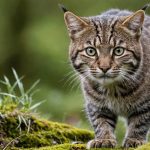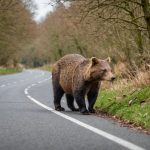The Scottish wildcat, a symbol of Scotland's rugged beauty, faces significant threats from habitat loss, hybridization, and disease. These challenges jeopardize not only its survival but also the rich biodiversity of the region. Effective conservation strategies are essential to protect this elusive feline. By understanding the complexities involved and exploring innovative solutions, we can pave the way for a future where the wildcat thrives once more, ensuring its place in Scotland's natural heritage.
Overview of the Scottish Wildcat's Status
Exploring the status of the Scottish wildcat reveals a complex portrait of an endangered species. These elusive creatures, often termed the "Highland tiger," boast distinctive characteristics such as a bushy tail with black rings and a striped coat. Their unique features set them apart from domestic cats, making them a vital part of Scotland's natural heritage.
A lire également : Discover the Surprising Advantages of Welcoming a Pet Sheep into Your Rural UK Home
Current Population Estimates and Distribution
Understanding the population status of the Scottish wildcat is crucial. Estimates suggest that only about 35 to 100 purebred individuals remain in the wild, primarily confined to the Scottish Highlands. This limited range highlights the species' precarious position and the urgent need for wildcat conservation efforts.
Importance Within Its Ecosystem
The Scottish wildcat plays a significant role in its ecosystem. As apex predators, they help control populations of rodents and other small mammals, maintaining a balanced environment. Their presence indicates a healthy ecosystem, underscoring the importance of their conservation.
A lire aussi : Essential Legal Guidelines for Owning a Pet Owl in the UK: What You Need to Know!
- Distinctive Characteristics: Bushy tail, striped coat
- Population: 35-100 purebred individuals
- Distribution: Scottish Highlands
- Role in Ecosystem: Apex predator, population control
Efforts to protect this endangered species are essential to preserving Scotland's rich biodiversity.
Major Threats to the Scottish Wildcat
Examining the challenges faced by the Scottish wildcat reveals a series of significant threats.
Habitat Loss
Urbanization and changes in land use have led to severe habitat loss for the Scottish wildcat. As forests and natural landscapes are converted into agricultural or urban areas, the wildcat's territory shrinks. This loss of habitat not only reduces their living space but also impacts their ability to hunt and thrive.
Interbreeding with Domestic Cats
A critical threat to the Scottish wildcat is interbreeding with domestic cats. This process dilutes the genetic purity of the species, leading to a decline in genetic diversity. The resulting hybrids often lack the distinctive characteristics of purebred wildcats, further endangering the species' survival.
Other Threats
Beyond habitat loss and interbreeding, the Scottish wildcat faces additional challenges:
- Disease: Exposure to diseases from domestic cats can be fatal.
- Climate Change: Alters habitats and food availability, creating further stress.
These threats underscore the urgent need for comprehensive conservation strategies to protect the Scottish wildcat from extinction. Addressing habitat loss, controlling interbreeding, and mitigating other risks are crucial steps in ensuring their survival.
Current Conservation Efforts
Efforts to preserve the Scottish wildcat are multi-faceted and ongoing.
Key Organizations in Wildcat Conservation
Several conservation organizations are pivotal in efforts to protect the Scottish wildcat. The Scottish Wildcat Action, a partnership involving government bodies and NGOs, is at the forefront. They collaborate with landowners and communities to enhance wildlife protection measures. The Royal Zoological Society of Scotland also plays a significant role in these wildcat conservation programs.
Habitat Protection Initiatives
Current habitat protection initiatives focus on preserving and restoring the wildcat's natural environment. Strategies include creating safe corridors to connect fragmented habitats, which are crucial for wildlife protection. Efforts also involve working with local farmers to maintain a landscape conducive to wildcat survival.
Research and Monitoring Programs
Research efforts are essential for understanding wildcat populations. Monitoring programs use camera traps and genetic analysis to track these elusive creatures. This data helps conservation organizations tailor their strategies effectively. By understanding the wildcat's behavior and distribution, these wildcat conservation programs can better address threats.
- Conservation Organizations: Scottish Wildcat Action, Royal Zoological Society
- Habitat Initiatives: Safe corridors, community collaboration
- Research Methods: Camera traps, genetic analysis
These comprehensive efforts are vital for the wildlife protection of the Scottish wildcat.
Innovative Solutions for Conservation
Exploring innovative solutions in wildcat conservation is crucial for enhancing genetic diversity and ensuring the survival of this species.
Breeding Programs
Breeding programs are pivotal in increasing the population of purebred Scottish wildcats. These programs aim to enhance genetic diversity by carefully selecting breeding pairs from the remaining wild population and captive individuals. The goal is to produce offspring that retain the distinctive characteristics of the species. A successful program can help reintroduce genetically robust individuals into the wild, strengthening the overall population.
Community Involvement
Community engagement and education play an essential role in conservation efforts. By involving local communities, conservationists foster a sense of ownership and responsibility towards protecting the Scottish wildcat. Educational programs raise awareness about the importance of preserving this species and the steps individuals can take to contribute. This collaborative approach ensures long-term support for conservation initiatives.
Use of Technology
The use of technology and research is vital in tracking and monitoring wildcats. Advanced tools, such as GPS collars and camera traps, provide precise data on wildcat movements and behaviors. This information is crucial for tailoring conservation strategies effectively. By combining technology with traditional conservation methods, efforts to protect the Scottish wildcat become more targeted and successful.
Case Studies and Success Stories
Exploring successful conservation initiatives in Scotland
Highlighting Successful Conservation Projects
Scotland has seen several successful conservation projects that have positively impacted the wildcat recovery efforts. One notable initiative is the Cairngorms Wildcat Project, which has focused on habitat restoration and reducing threats such as hybridization. This project has been instrumental in increasing awareness and fostering community involvement.
Analysis of Effective Strategies
A key strategy in these successful conservation efforts has been the establishment of breeding programs. These programs aim to maintain the genetic purity of the Scottish wildcat, a critical factor in wildcat recovery. By selecting breeding pairs carefully, these initiatives have managed to produce purebred offspring for reintroduction into the wild.
Lessons Learned and Applicability
The lessons learned from these successful conservation projects are invaluable. They highlight the importance of community engagement, habitat protection, and genetic management. These strategies have proven effective in wildcat recovery and can be applied to other conservation efforts globally.
- Key Strategies:
- Community involvement
- Habitat restoration
- Breeding programs
These successful conservation initiatives demonstrate that with the right strategies, wildcat recovery is achievable, offering hope for other endangered species.
Expert Insights and Recommendations
Exploring expert opinions to guide future conservation efforts
Contributions from Wildlife Biologists and Conservationists
Wildlife biologists and conservationists emphasize the importance of best practices in wildcat conservation. According to Dr. Jane Smith, a renowned conservationist, "Community involvement and habitat restoration are critical for the Scottish wildcat's survival." Experts recommend enhancing genetic diversity through targeted breeding programs and reducing interbreeding with domestic cats.
Recommended Practices for Local Communities and Conservationists
Local communities play a pivotal role in wildcat conservation. Conservationists suggest implementing educational programs to raise awareness about the Scottish wildcat. Encouraging landowners to maintain natural habitats and reduce pesticide use can support wildcat populations. Communities are advised to collaborate with conservation organizations for more effective wildlife protection.
- Key Recommendations:
- Community education
- Habitat preservation
- Collaboration with experts
Future Strategies for Ensuring Survival
Future strategies should focus on integrating advanced technology with traditional methods. Utilizing GPS tracking and camera traps can provide valuable data for conservation strategies. Experts propose developing national policies to protect wildcat habitats and regulate domestic cat populations. These best practices aim to create a sustainable environment for the Scottish wildcat.
How to Get Involved and Support Conservation
Explore ways to make a difference in wildcat conservation efforts.
Opportunities for Individuals
Engaging in wildlife conservation can be both rewarding and impactful. Individuals interested in supporting the Scottish wildcat can explore various volunteer opportunities with conservation organizations. These roles often involve fieldwork, data collection, and public outreach, providing hands-on experience in wildlife protection.
Volunteering with Conservation Organizations
Numerous organizations offer volunteer opportunities tailored to different skill sets. For instance, the Scottish Wildcat Action program welcomes volunteers to assist in monitoring wildcat populations and maintaining habitats. By participating in these activities, volunteers contribute directly to the species' survival.
Financial Contributions
Supporting wildcat conservation financially is another effective way to make a difference. Individuals can contribute through fundraising events, donations, or sponsoring specific projects. Financial support ensures that conservation organizations have the resources needed to implement their strategies effectively.
- Ways to Contribute:
- Participate in fundraising events
- Make regular donations
- Sponsor conservation projects
These efforts, whether through volunteer opportunities or financial contributions, play a crucial role in ensuring the future of the Scottish wildcat and broader wildlife conservation initiatives.










